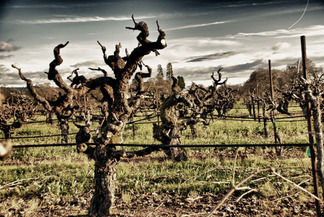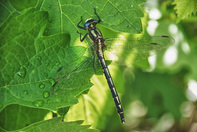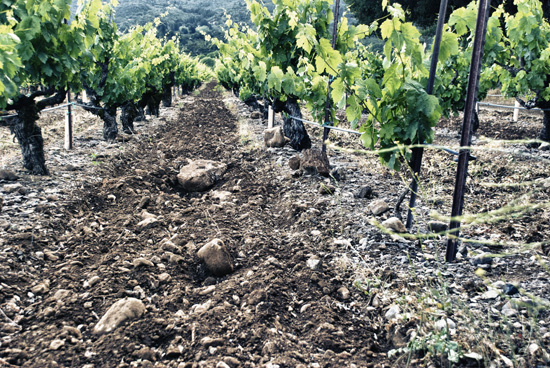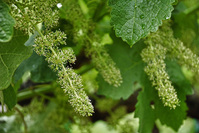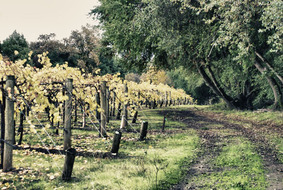Bedrock Vineyard - Sonoma Valley
Story: Lisa Supple
Photography: Cathleen Francisco and Peter Griffith
Photography: Cathleen Francisco and Peter Griffith
This historic vineyard was once part of a larger 300-acre property owned by General M.G. Vallejo.
Based in Sonoma (the town he founded), Vallejo was the Commandante of the Mexican territory of Alta California. In 1836, foreseeing that California wouldn’t belong to Mexico much longer and he would be stripped of his vast holdings, Vallejo gifted the 300 acres to his daughter’s music teacher. After the Bear Flag Revolt in 1846 and the creation of the American Republic of California, the music teacher sold it to George Washington Whitaker, who planted Mission grapes and fruit orchards. In 1856, General Joseph Hooker (bankrolled by William Tecumseh Sherman, a San Francisco banker before he was an infamous Union general) bought the land and planted the first Vitis vinifera grapevines at Bedrock. When the Civil War began, Hooker sold the property to Eli T. Shephard, a U.S. Ambassador to the Far East. After phylloxera had devastated the vineyard, George Hearst (father of publishing magnate William Randolph Hearst) bought the ranch and began replanting in 1884.
The property changed hands a few more times in coming years and eventually was split in two. Half was purchased by the Domenici family, who farmed it for nearly 100 years. In 1978, the Domenicis sold a small middle section to Judge Patricia Herron, who named her vineyard Barricia. In 2005, the Domenicis sold the remaining acreage to Joel Peterson, who called it Bedrock. “After founding Ravenswood and making wines for many years with other people’s grapes, it felt like I was putting my stake into the bedrock of Sonoma Valley.”
|
Imposingly gnarled, pruned in the gobelet style of head pruning with the branches spiraling upward around the massive trunk, some of these 120+ year old vines stand six feet tall. "Old vineyards like Bedrock are California’s treasures, a melting pot of old grape varieties. But they offer much more than historical value; they’d be nowhere if they didn't make very, very good juice." Morgan Twain-Peterson |
Some of the old Zin is widely spaced, planted 10 foot x 10 foot. Up a slight rise, it shifts to 8x8 foot spacing where the soil is rockier and more shallow, and the vines don’t get as big. That’s the way they did it back then. Everything was dry farmed; they let the vines grow big and didn’t make them compete too much. Modern thinking leans more toward reining in growth and yields. So 10 to 15 years ago, new Zin vines were interplanted in between the oldsters. The vineyard is still minimally irrigated, with drip irrigation used as needed.
Cover crop is used to improve soil tilth and health, and gets hip-high in spring. In low-vigor soils, it’s mulched down and disced in, acting as green manure to health-up the soil. In higher capacity, more vigorous soils, a no-till program is in effect. The cover crop is mowed down in summer but never cultivated. In moderate capacity soils, alternate rows are mowed and cultivated.
Cover crop is used to improve soil tilth and health, and gets hip-high in spring. In low-vigor soils, it’s mulched down and disced in, acting as green manure to health-up the soil. In higher capacity, more vigorous soils, a no-till program is in effect. The cover crop is mowed down in summer but never cultivated. In moderate capacity soils, alternate rows are mowed and cultivated.
|
Climate: Bedrock is in the “Banana Belt” of Sonoma Valley – a narrow part of the valley where temperatures are warmer and there’s less fog and wind. Unlike vineyards around Kenwood to the North and Carneros to the South, there’s rarely any need for frost protection here. |
Soil types: The vineyard is split by Hooker Creek running east to west. The northern section is primarily Tuscan cobbley loam; in the southern blocks, soils are Red Hills clay loam. These are very old soils, evident in their deep red, iron-oxide color. Near the Sonoma Creek on the property’s southwestern border, soils are dark brown, Huichica clay loam. As the vineyard rises 10 to 20 feet toward the Mayacamas Mountains to the East, the earth becomes rockier, shallower, and less vigorous.
|
Topography: Relatively flat with 360° exposure, from an hour or two after sunrise when the sun crests the tops of the Mayacamas until it dips behind Sonoma Mountain to follow its arc into the Pacific. |
|
Varieties:
Bedrock has 35+ acres of ancient, pre-1890 vines – mostly Zinfandel with smaller blocks of Mourvedre, Carignane and other mixed-black grapes like Petite Sirah, Barbera and Alicante Bouschet that were popular in the field blends of that era. Also sprinkled in with the old-vine Zin are as many as 30 obscure varieties, including Mondeuse, Peloursin, Serine, Tempranillo, Grand Noir de la Calmette and Negrette. |
Other varieties grown:
Other varieties at Bedrock include Bordeaux reds – Cabernet Sauvignon, Cab Franc, Merlot, Petit Verdot. Mostly planted on modified Geneva Double Curtain, this trellising is well suited to moderate-vigor soils and allows the grape clusters to hang free while also protecting them from too much exposure to the sun. |
There's also a research block of 20 different clones of head-trained Zinfandel planted in 2008 in cooperation with UC Davis.
|
Owner: Joel Peterson
Farmed by: Diane Kenworthy, Sunbreak Vineyard Services Acreage: 150 acres total; 120 planted to vines Wineries who source the fruit: Ravenswood, Bedrock Wine Company, Franciscan, KEATING, Simi, Carlisle, Clos du Bois. Turley, Bialle, Dashe, Jason Kesner, Enkidu, Rudius, Windgap, Kunde, Orin Swift, JC Cellars, Rowland-Tebb, Mondavi and Sebastiani. |
Vineyard Access: Private property,
no public access. Member of the Historic Vineyard Society http://historicvineyardsociety.org/ |
With three creeks running through it and a (now capped) hot spring, Bedrock is home to deer, mountain lions, bobcats, coyotes, rabbits, river mink and many birds. No insecticides are used here. Songbird boxes attract western bluebirds and swallows. The swallows hunt on the fly, nabbing airborne leafhoppers and mosquitoes; the bluebirds eat the creepy crawlers and moth larvae. Rodents (gophers and field mice) are dispatched by resident owls that live in owl boxes, which face moonrise so the night hunters can sleep during the day.
|
Member of the Historic Vineyard Society : http://historicvineyardsociety.org/
